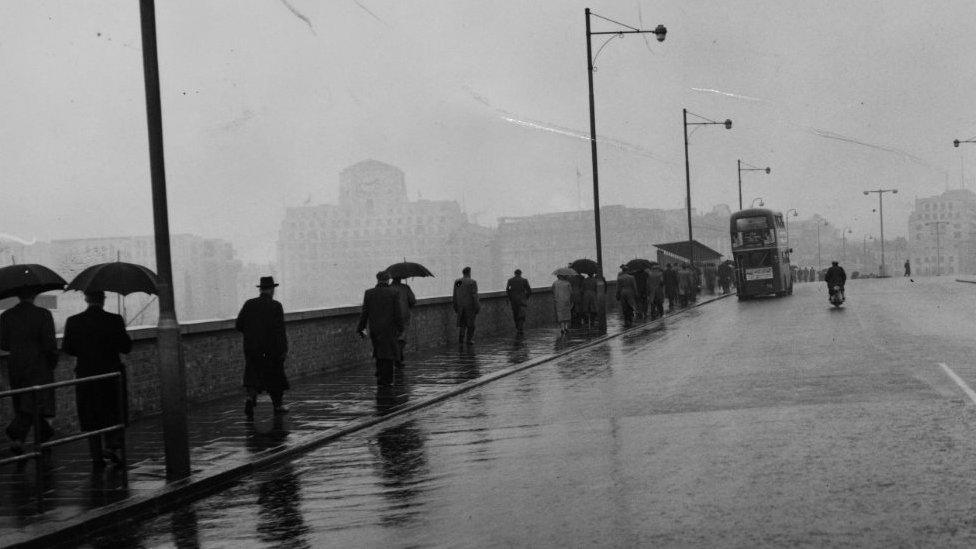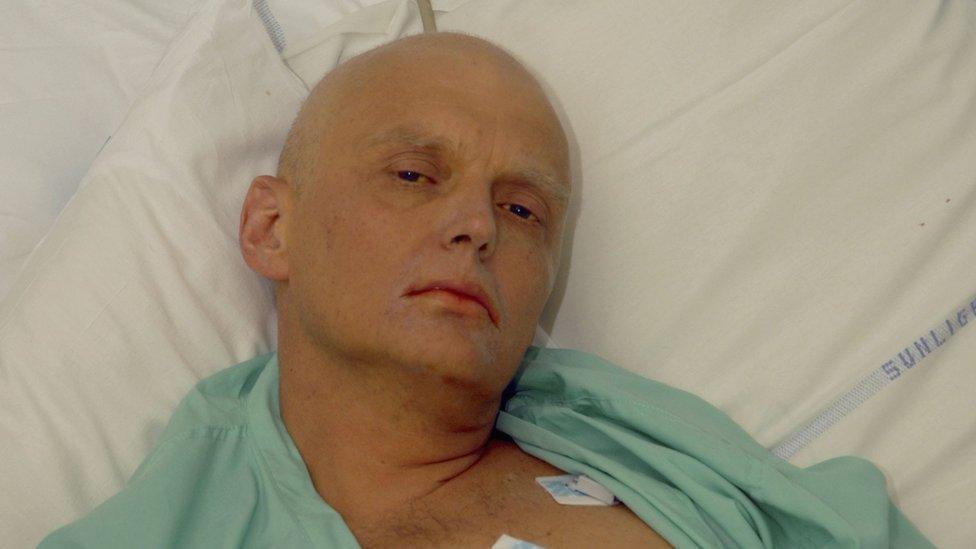The world's most unusual assassinations
- Published

Waterloo Bridge in London was the scene of one of the strangest killings
There is nothing new about a high-profile or outspoken person being assassinated.
It is one of the oldest tools in the book to get rid of someone who is either too powerful, too dangerous or too inconvenient.
But most assassins choose a straight-forward method: Julius Caesar was stabbed to death, Abraham Lincoln was shot.
It is now being speculated that the death of Kim Jong-nam - Kim Jong-un's oldest half-brother - may have been another one.
If that proves true, its rumoured method - which supposedly saw two female assassins placing a poison-laced handkerchief over his mouth as he walked through the airport - puts his assassination among a select list of those killed by people who have chosen a more unusual route.

The Polonium tea
Alexander Litvinenko's death is arguably the most high profile assassination of recent years.
The former KGB agent became ill on 1 November 2006, hours after having tea at the upmarket Millennium Hotel in Mayfair with two fellow former agents.
After his death, those agents would become the main suspects in his murder.

Alexander Litvinenko was poisoned by tea laced with Polonium 210
When Mr Litvinenko was admitted to hospital on 3 November, he told doctors he had been poisoned.
Later, he would personally name Russian President Vladimir Putin, saying he was responsible for "everything that happened to him".
Meanwhile, his hair began to fall out and his organs began shutting down - but doctors at London's University College Hospital could not find a cause.
Read more: Profile of murdered Russian spy
Eventually, it fell to scientists at Britain's top-secret nuclear research site at Aldermaston in Berkshire to discover what was killing Mr Litvinenko from the inside: Polonium 210, a particle which was used in the first nuclear bombs, and is 100% deadly.
There was nothing doctors could do.
Mr Litvinenko, who told the BBC's Russia service he had been looking into the assassination of Russian journalist Anna Politkovskaya the previous month when he was attacked, died on 23 November.
The poisoned umbrella
Bulgarian dissident Georgi Markov was waiting for a bus on Waterloo Bridge on 7 September 1978 when he felt a stab in his thigh.
Mr Markov, 49, looked back to see a man with an umbrella running away and taking a taxi.
It was only later, after finishing a day's work for the BBC's Bulgarian service and having returned home to south London, that he became unwell.
Witness: Markov
Mr Markov, an opponent of Bulgaria's then-Communist government, died four days later.
He had, officials later discovered, been poisoned with ricin which appeared to have been injected into his thigh, possibly by the umbrella.
No one was ever charged with his murder, one of the most notorious of the Cold War, but Mr Markov had his own theories, telling doctors he believed the KGB had played a role in the attack.
The axe-wielding bear
Jörg Jenatsch was a one-time preacher who went on to be a politician and leading figure during Switzerland's 30 Year War.
But for all his achievements in life, it is probably Mr Jenatsch's death in 1639 in a hostel in Chur which is most memorable.

Swiss politician Jörg Jenatsch was murdered by a man dressed as a bear in 1639
Mr Jenatsch, who had recently been knighted for his services, was having a party during the town's carnival when a group turned up and asked to join in.
Their leader was apparently dressed as a bear.
The group was allowed to enter and the bear - whose identity was never discovered - unceremoniously hacked Mr Jenatsch to death with an axe.
But don't feel too bad for him: legend apparently has it that the axe used was the same one he wielded while murdering another rival.
The hot poker
More than 700 years may have passed since Edward II met his untimely end in Gloucestershire, but it still has the ability to make us wince.
What we know for sure is this: Edward II was captured and forced to abdicate the throne in favour of his son, who would become Edward III, after his wife, Isabella with her lover, Roger Mortimer, invaded England in 1326.
Edward II was then locked up in Berkeley Castle where he died the next year.

Historians have questions over just how Edward II died
But according to stories passed down from generation to generation, this was no quiet passing in his sleep.
Instead, the story goes he had a red-hot poker inserted into his anus, fatally burning his internal organs but, conveniently, leaving no mark.
The story may have been dismissed as medieval propaganda by a number of historians over the years, but it hasn't stopped those interested in the gorier side of history continuing to tell it anyway.
The, well, everything
Sometimes, even the most carefully laid plans can go wrong.
And then there are times that even your back-up fails - which, if legend is to believed, is exactly what happened to the men behind the assassination of Grigory Rasputin in 1916.
It appears a few aristocrats had become fed up with the mystic peasant who captivated the Russian imperial court and decided to dispose of him in that time honoured way, murder.
But after luring him to the palace of Prince Felix Yusupov in St Petersburg, things began to go wrong.

Grigory Rasputin, the Siberian mystic said to have healing powers, was killed in 1916
His assassins, Prince Yusupov and Vladimir Purishkevich, a member of parliament, first fed him poisoned cake.
The story goes it had no impact, and so the bemused killers turned to their guns.
Their initial shots failed to down him, and their blows to the head were unsuccessful too.
If his assassins are to be believed, it took another four shots to finally kill Rasputin - although a different myth suggests they had to drown him in an icy lake to end his life.
Is any of this true? Well, the pathologists put his cause of death down to a shot to the stomach causing heavy blood loss. Apart from that, it seems unlikely.
- Published14 February 2017

- Published25 June 2014

- Published20 December 2016

- Published22 November 2013
